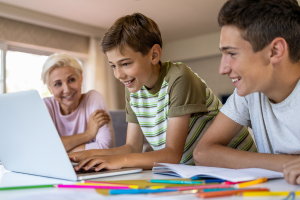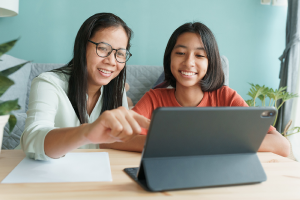“Mom, how do you block people on Instagram? I can’t figure it out,” yelled 13-year old Chloe casually from the top of the stairs. Chloe tried to mask the urgency to her question. She had just discovered several bluntly inappropriate comments beneath a photo she posted of herself on Instagram.
 A month earlier Monica agreed that Chloe could open an Instagram account if she put her settings on “private,” and only exchanged photos with a small group of close friends (Monica being one of them). Chloe loved photography and Instagram’s dramatic filters and photo retouching was a fun tool to help grow her new hobby.
A month earlier Monica agreed that Chloe could open an Instagram account if she put her settings on “private,” and only exchanged photos with a small group of close friends (Monica being one of them). Chloe loved photography and Instagram’s dramatic filters and photo retouching was a fun tool to help grow her new hobby.
Turns out Chloe did max her privacy settings—for a week or two. But a fun trip to the beach, a good hair day, and some “super cute” new school clothes proved too tempting for the teen not to share her life highlights with a wider circle. So she removed her privacy settings, which opened her photo stream to strangers who, in this incident, happened to be several older men inappropriately soliciting younger girls online.
Chole’s confession came out slowly—in bits and pieces—but it came. Tears spilling from beneath downcast eyes, Chloe told her mom, “I’m not exactly sure what they meant by their comments but when I read them I felt scared. It felt really wrong just to read them—like something really gross.”
Even the most trustworthy, well-intentioned, responsible kids will push the boundaries of privacy online. It’s as natural as breaking curfew or stretching the truth once in a while in the course of growing up. Still, pushing boundaries in the digital world can take consequences to frightening levels. Flirtatious, mean, or crude comments to a teen can be confusing, scary, and emotionally harmful.
Instagram is no different and because it’s a photo-driven social network, it requires diligent monitoring, proper filtering, and constant communication with your kids in order to keep it fun and safe. The same threats of cyber bullying, sexting, and predators apply.
What you need to know:
- Instagram is a photo-sharing mobile app on both iphones and androids and it is a social network. Users can either upload a photo from their device’s library or take a photo from the Instagram platform and use a variety of photo filters and tools to make the photo more dramatic. The app is so popular, Facebook purchased it this year and it’s quickly becoming one of the leading social networks (currently ranked #11).
- Get passwords. According to Instagram, a parent cannot request access to a child’s account. They state: “…we cannot give you access to the account or take any action on the account at your request. We are generally forbidden by privacy laws against giving unauthorized access to someone who is not an account holder. Please note that all users ages 13 and older are considered authorized account holders and are included in the scope of this policy.” So, we suggest you get your children’s passwords to Instagram and check them constantly to be sure settings remain private.
- Make sure Photo Map (Geo Tagging) feature is clicked off on photos. If your child has activated their Photo Map they can remove all map-approved photos, which will disable their Photo Map. Navigate to profile, tap the “Photo Map” button that appears in the upper right corner, navigating to the stacks of images that appear, and deselect all images (tap green check marks) in the grid review view.
- Age requirement: Instagram is not for children under the age of 13 and has strict Use and Community Guidelines on age requirement.
- If your account is set to private, only those users who you’ve approved will see your activity. To set your profile to private, tap the Profile tab—turning ON the “Photos are private” switch. Once your account is set to private, users will have to send you a request to follow you, which you can either allow or deny.
- The News feed makes it easier to discover photos posted by others whom you follow on Instagram. The “Following” tab on your News Feed shows activity among those you follow. It will display photos they have liked, other users they’ve started following, and comments between users that you are following.
- The only way to remove someone from your list of followers is to block them.
- How to block a user:
- Navigate to the person’s profile page.
- Tap the button in the top right corner of the screen (arrow in box icon).
- Tap “Block user” to prevent the user from viewing your account.
- Report a user with Instagram’s built-in flagging feature. In order to flag a photo tap the “…” (three dots icon) below the photo you want to report and then chose “Report Inappropriate.” Photos can be reported for nudity, prohibited or illegal content, violence and gore, or the promotion and glorification of self-harm.
- Instagram is a very user-friendly, easy-to-navigate interface that anyone can log into and enjoy. For questions and troubleshooting consult the Help Center, Tips for Parents, and Community Guidelines at Instagram.com.
It is critical to take the necessary time to know the technology your kids are using every day. This task doesn’t have to be overwhelming. Usually a quick download of an app, creating your own account on a social network, and visiting a platform’s Help Center is all it takes to get informed and keep kids safe. The extra effort—about 30-40 minutes per network—it is is well worth it.












